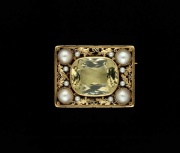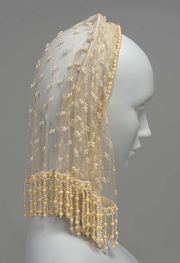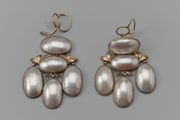Difference between revisions of "Pearl"
| Line 11: | Line 11: | ||
== Risks == | == Risks == | ||
| − | + | [[File:Pearl earrings.jpg|thumb|Pearl earrings<br>MFA# 43.2122]] | |
Easily damaged by acids. Deteriorates at low humidities. Easily scratched. May be discolored by soap or skin oil. | Easily damaged by acids. Deteriorates at low humidities. Easily scratched. May be discolored by soap or skin oil. | ||
== Physical and Chemical Properties == | == Physical and Chemical Properties == | ||
Revision as of 13:16, 12 August 2020
Description
A smooth, opaque, iridescent gem formed as a multilayered Nacre deposit around foreign matter embedded in the shells of mollusks. Nacre is composed of Aragonite crystals bound together with Conchiolin. The nacre is built up in thin, concentric layers that grow at rates of less than a millimeter per year. Large, natural pearls a rarity with the largest known pearl weighing 93 grams. The shape of the pearl depends on the shape of the embedded inclusion so most natural pearls are not spherical. Salt-water pearls, also called Oriental pearls, are found in the Persian Gulf, Gulf on Mannar, Myanmar, Tahiti, Borneo, New Guinea, Venezuela, and Australia. Since 1920, pearls have been cultured commercially.
See also Pearl, cultured, and Pearl, freshwater.
Synonyms and Related Terms
pearls; natural pearls; Oriental pearls; perle (Dan., Fr.); Perle (Deut.); perla (Esp.); parel (Ned.); pérola (Port.); parel (Ned.)
Risks
Easily damaged by acids. Deteriorates at low humidities. Easily scratched. May be discolored by soap or skin oil.
Physical and Chemical Properties
- Specific gravity for natural and Oriental pearls = 2.68-2.74; for cultured pearls = 2.70-2.79; and for freshwater pearls = 2.68
- Texture: slightly rough
- Luster: pearly (iridescent)
- Color: white, pale yellow, pink, gray, brown, black
- Most exhibit a sky -blue color fluorescence
- Mohs Hardness = 3 - 4
- Density = 2.68-2.4
Resources and Citations
- Oppi Untracht, Jewelry Concepts and Technology, Doubleday & Co., Inc., New York City, 1985 Comment: specific gravity for Oriental pearls = 2.68-2.74, cultured = 2.70-2.79, freshwater pearls = 2.68; average hardness = Mohs 3-4; double refraction = 1.57
- Jack Odgen, Jewellery of the Ancient World, Rizzoli International Publications Inc., New York City, 1982
- Encyclopedia Britannica, http://www.britannica.com Comment: "pearl." Accessed 23 Dec. 2004 .
- Website: http://www.geo.utexas.edu/courses/347k/redesign/gem_notes/pearl/pearl_main.htm -Gives density of natural pearls as 2.66-2.78 and cultured pearls as 2.72-2.78
- Wikipedia: http://en.wikipedia.org/wiki/Pearl (Accessed Nov. 9, 2005)
- G.S.Brady, Materials Handbook, McGraw-Hill Book Co., New York, 1971
- Caring for your Collections, Arthur W Schulz (ed.), Harry N. Abrams, Inc. , New York, 1992
- Art and Architecture Thesaurus Online, http://www.getty.edu/research/tools/vocabulary/aat/, J. Paul Getty Trust, Los Angeles, 2000


